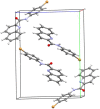Microwave-assisted synthesis of new substituted anilides of quinaldic acid
- PMID: 22293847
- PMCID: PMC6268041
- DOI: 10.3390/molecules17021292
Microwave-assisted synthesis of new substituted anilides of quinaldic acid
Abstract
In this study a one step method for the preparation of substituted anilides of quinoline-2-carboxylic acid was developed. This efficient innovative approach is based on the direct reaction of an acid or ester with substituted anilines using microwave irradiation. The optimized method was used for the synthesis of a series of eighteen substituted quinoline-2-carboxanilides. The molecular structure of N-(4-bromophenyl)quinoline-2-carboxamide as a model compound was determined by single-crystal X-ray diffraction. It crystallizes in the monoclinic space group with four molecules within the unit cell and the total structure of the compound can be described as "a slightly screwed boat".
Figures





Similar articles
-
Discovery of novel 4-(2-fluorophenoxy)quinoline derivatives bearing 4-oxo-1,4-dihydrocinnoline-3-carboxamide moiety as c-Met kinase inhibitors.Bioorg Med Chem. 2013 Jun 1;21(11):2843-55. doi: 10.1016/j.bmc.2013.04.013. Epub 2013 Apr 16. Bioorg Med Chem. 2013. PMID: 23628470
-
Microwave-assisted, solid-phase synthesis of a chiral 1,2,3,4-tetrahydro-quinoline library.Comb Chem High Throughput Screen. 2006 Nov;9(9):691-701. doi: 10.2174/138620706778700134. Comb Chem High Throughput Screen. 2006. PMID: 17100574
-
Rapid synthesis of quinoline-4-carboxylic acid derivatives from arylimines and 2-substituted acrylates or acrylamides under indium(III) chloride and microwave activations. Scope and limitations of the reaction.Org Biomol Chem. 2005 Oct 21;3(20):3794-804. doi: 10.1039/b509400c. Epub 2005 Sep 9. Org Biomol Chem. 2005. PMID: 16211116
-
Microwave-Assisted Synthesis of Diversely Substituted Quinoline-Based Dihydropyridopyrimidine and Dihydropyrazolopyridine Hybrids.ACS Comb Sci. 2017 Aug 14;19(8):555-563. doi: 10.1021/acscombsci.7b00091. Epub 2017 Jul 26. ACS Comb Sci. 2017. PMID: 28723092
-
Microwave-assisted synthesis of substituted hexahydro-pyrrolo[3,2-c]quinolines.Molecules. 2007 Jan 24;12(1):49-59. doi: 10.3390/12010049. Molecules. 2007. PMID: 17693952 Free PMC article.
Cited by
-
Proline-Based Carbamates as Cholinesterase Inhibitors.Molecules. 2017 Nov 14;22(11):1969. doi: 10.3390/molecules22111969. Molecules. 2017. PMID: 29135926 Free PMC article.
-
Crystal structures of three N-(3-acetyl-phen-yl)quinoline-2-carboxamides.Acta Crystallogr E Crystallogr Commun. 2017 May 5;73(Pt 6):804-808. doi: 10.1107/S2056989017006272. eCollection 2017 Jun 1. Acta Crystallogr E Crystallogr Commun. 2017. PMID: 28638631 Free PMC article.
-
SAR-mediated Similarity Assessment of the Property Profile for New, Silicon-Based AChE/BChE Inhibitors.Int J Mol Sci. 2019 Oct 29;20(21):5385. doi: 10.3390/ijms20215385. Int J Mol Sci. 2019. PMID: 31671776 Free PMC article.
-
Ionically Cross-Linked Chitosan Nanoparticles for Sustained Delivery of Docetaxel: Fabrication, Post-Formulation and Acute Oral Toxicity Evaluation.Int J Nanomedicine. 2019 Dec 20;14:10035-10046. doi: 10.2147/IJN.S232350. eCollection 2019. Int J Nanomedicine. 2019. PMID: 31908458 Free PMC article.
-
N-Alkoxyphenylhydroxynaphthalenecarboxamides and Their Antimycobacterial Activity.Molecules. 2016 Aug 16;21(8):1068. doi: 10.3390/molecules21081068. Molecules. 2016. PMID: 27537867 Free PMC article.
References
-
- Kharkar P.S., Deodhar M.N., Kulkarni V.M. Design, synthesis, antifungal activity, and ADME prediction of functional analogues of terbinafine. Med. Chem. Res. 2009;18:421–432.
-
- Musiol R., Serda M., Hensel-Bielowka S., Polanski J. Quinoline-based antifungals. Curr. Med. Chem. 2010;17:1960–1973. - PubMed
-
- Nakamoto K., Tsukada I., Tanaka K., Matsukura M., Haneda T., Inoue S., Murai N., Abe S., Ueda N., Miyazaki M., et al. Synthesis and evaluation of novel antifungal agents-quinoline and pyridine amide derivatives. Bioorg. Med. Chem. Lett. 2010;20:4624–4626. - PubMed
Publication types
MeSH terms
Substances
LinkOut - more resources
Full Text Sources

